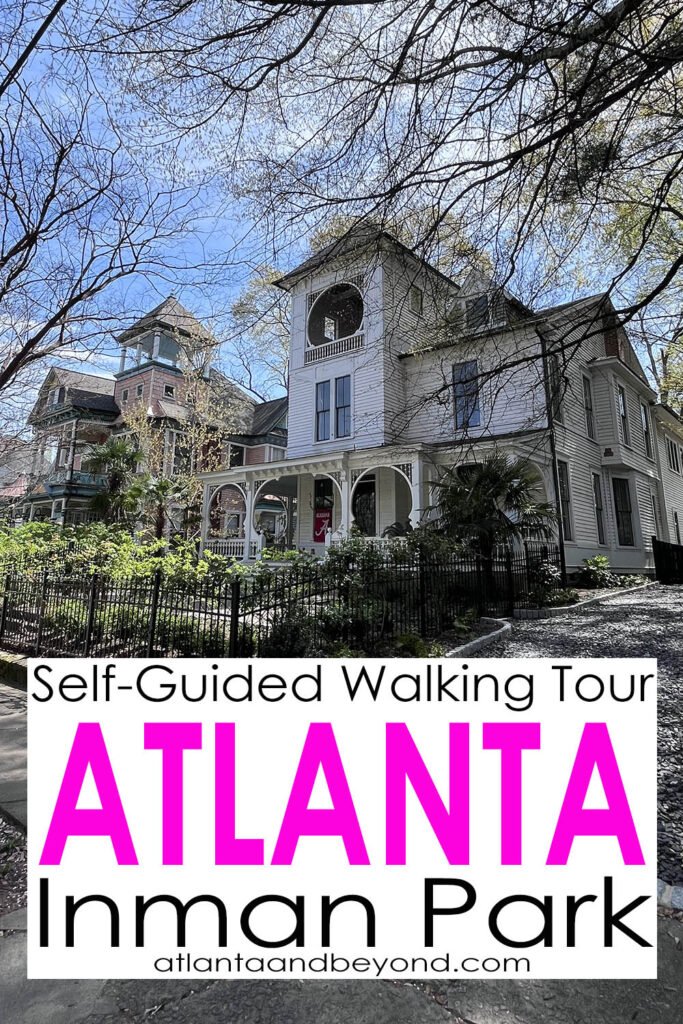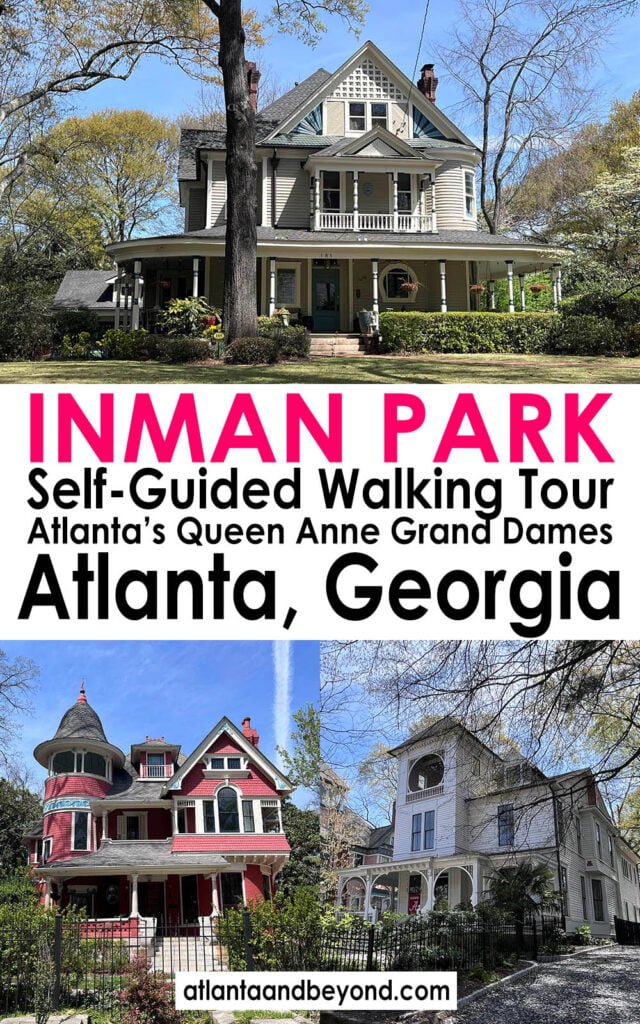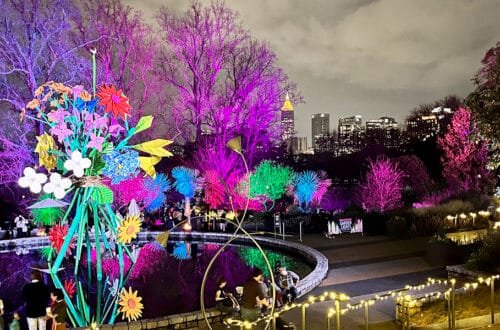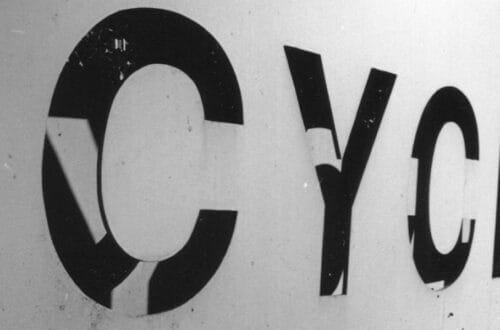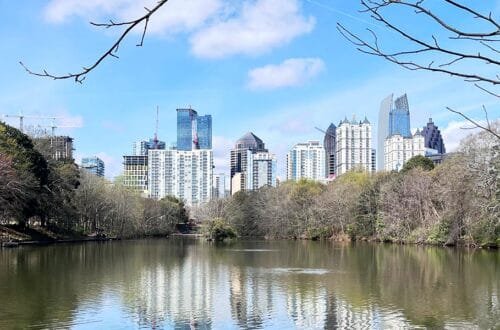
Atlanta’s Inman Park: Self-Guided Walking Tour
Inman Park’s Grand Dames
This free self-guided walking tour of Atlanta’s historic Inman Park neighborhood focuses on the large Queen Anne Victorian houses that were popular at the turn of the last century. They are lovingly known as the “Grand Dames” in Inman Park. Other places such as San Francisco, call their Victorian beauties, “Painted Ladies.”
Joel Hurt developed Inman Park as Atlanta’s first streetcar suburb in the 1880s. Due to its period of reconstruction following the Civil War, Atlanta was behind on architectural fashions. While you may assume that Inman Park’s Grand Dames would have all had elaborate color schemes, many of them were simply painted white. The white paint schemes emulated the neoclassical buildings popularized by the 1893 World Columbian Exposition in Chicago. This trend is analogous to today’s white modern farmhouse craze.
Inman Park: Atlanta’s First Streetcar Suburb
Joel Hurt followed examples of suburbs in other parts of the country, such as the railroad suburb of Riverside, Illinois, when he designed Inman Park. Hurt installed a new streetcar on Edgewood Avenue. His trolley conveniently took passengers from the Hurt building downtown to his new Inman Park neighborhood- named for his friend and business partner, Samuel Inman.
Hurt electrified the trolley making it Atlanta’s first electric streetcar line. His Inman Park neighborhood offered the most up-to-date utilities including: water, sewer, gas, and streetlights. In the late 1880s and early 1890s, the most influential families of Atlanta, who were attracted to the garden setting, began building Inman Park’s Victorian Mansions and moved in. They hired the most prestigious Atlanta architects of the day including Willis Franklin Denny II, Gottreid L. Norrman, and Walter T. Downing to design their homes.
For a deeper dive into Inman Park’s neighborhood history, please read Inman Park: A Neighborhood History.
Inman Park Free Self-Guided Walking Tour Details
How to get to Inman Park
Driving
Park on Edgewood Avenue near the Inman Park Trolley Barn, which is where our tour will begin. The address is 963 Edgewood Ave NE, Atlanta. Free street parking should be readily available unless an event is taking place.
Ride Share: Uber of Lyft
Make your destination the Inman Park Trolley Barn, which is where our tour will begin. The address is 963 Edgewood Ave NE, Atlanta.
Public Transportation: MARTA
Take the MARTA train to Inman Park/Reynoldstown Station. The Inman Park Trolley Barn is approximately a 5 minute walk down Edgewood Ave once you exit the station.
- MARTA Bus Route 4 – Moreland Avenue
- MARTA Bus Route 6 – Clifton Road/Emory
- MARTA Bus Route 32 – Bouldercrest
- MARTA Bus Route 74 – Flat Shoals Road
- MARTA Bus Route 102 – North Avenue / Little Five Points
How long will the tour take?
The Self Guided Walking Tour of Atlanta’s Inman Park will take about 1:30 at a leisurely pace. Please note that this is a historic neighborhood and the sidewalks are often uneven. This route includes hills.
Is there somewhere to eat nearby?
Atlanta’s Inman Park neighborhood offers a huge variety of choices if you are looking to grab a bite before or after the walking tour. A couple of them are practically on the tour route! Here are a few recommendations:
- Kitty Dare – open for Dinner or Sunday Brunch – on Edgewood Ave near the MARTA Station
- The Daily Coffee Shop – stop in for breakfast, coffee, or a treat – on Hurt St near the MARTA Station
- Revolution Doughnuts – stop in for a morning or early afternoon treat – on the corner of Edgewood & Waddell
- Bocca Lupo – open for dinner – on the corner of Edgewood & Waddell
- Fritti – my favorite Italian-style pizza – on the corner of Elizabeth St and Highland Ave
- Del Bar – middle eastern cuisine – open for dinner and weekend brunch – on Highland Ave
- The Krog District – there are many food choices at Krog Street Market
Atlanta’s Inman Park Free Self-Guided Walking Tour
Trolley Barn 1889
963 Edgewood Ave
Shingle Style
This barn was located at the end of Joel Hurt’s streetcar service to his garden suburb. The building served as the trolley maintenance facility. Joel Hurt kept the office for the Atlanta and Edgewood Street Railway in the building as well. The building serviced trolley cars until 1907. At that time, the line had been extended and it was no longer needed.
A local Baptist congregation rented the space for its services for over 30-years. Note the stained-glass window that remains from that period. The trolley barn served a variety of services over the years, but by 1975 it was in such disrepair that it was on the verge of collapse. Neighbors convinced the City of Atlanta to purchase the property in 1976. Restoration commenced and was finally completed in 1987. The building primarily functions as an events facility today.
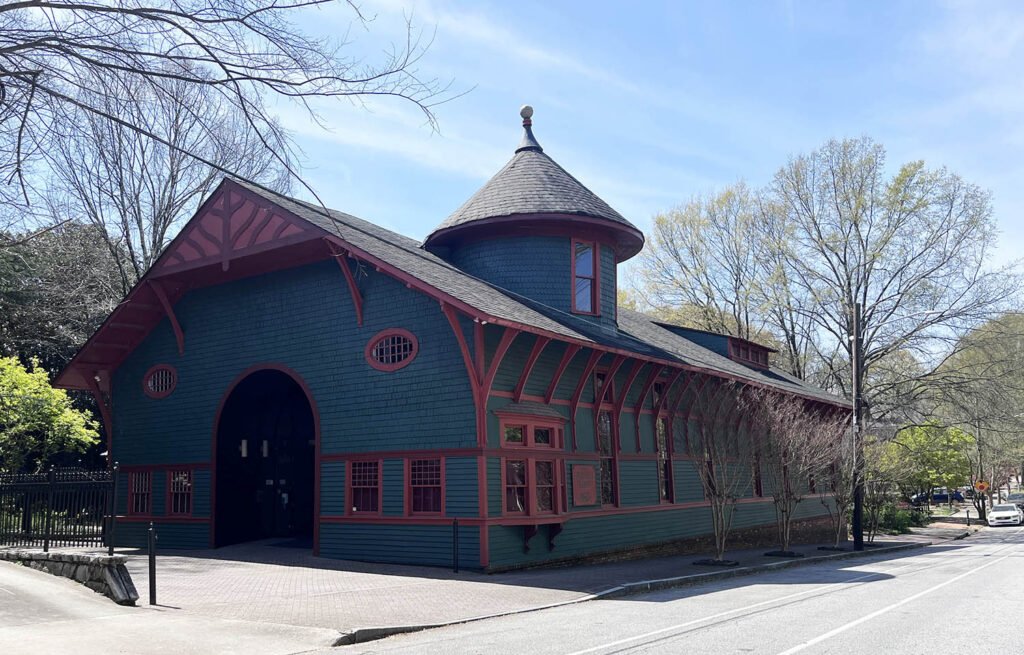
As you pass the southern end of Springvale Park on the right, note the historical markers related to the Battle of Atlanta.
Second Ernest Woodruff House 1902
908 Edgewood Avenue
Architect: Walter T. Downing
Jacobean Revival
As Joel Hurt’s bother-in-law, Ernest Woodruff, was able to purchase this prime piece of property that had originally been a park called the Mesa, which the grand dames across the street overlooked. Ernest hired Walter T. Downing to design this grand 26-room house for his family. The property surrounding this home included stables, tennis courts, and open land. Note that smaller homes on this block were constructed after the family sold the land surrounding the house.

LeCraw House 1890
897 Edgewood Ave
Architect: Gottfried L. Norrman
Queen Anne
This house was built by Hurt’s company as a spec house and initially it was rented. Charles and Daisy LeCraw rented the home for a few years before purchasing it for their family in 1903. Charles worked for the State Life Insurance Company of Indiana for over 40-years. He bought the field behind the house as a pasture for his animals. Their outbuildings included a stable for the horse that pulled the family carriage and their milk cows. Daisy enjoyed music. She and her children often performed the violin and the piano on their porch for the neighbors.

King-Keith House 1890
889 Edgewood Ave
Queen Anne
George King owned the King Hardware Company. His hardware empire grew to include around 40 stores across Georgia. He built this home for his family that included eight daughters and one son. One of King’s managers, Benjamin O. Fussell purchased the home from King in 1910. This family lived in the house until 1954. In 1955, the house was divided up into a boarding house. A payphone had been installed on the front porch. In 1976, the home was sold to a new owner and restoration began. Today, the Victorian period exterior color scheme displays 13 different colors.
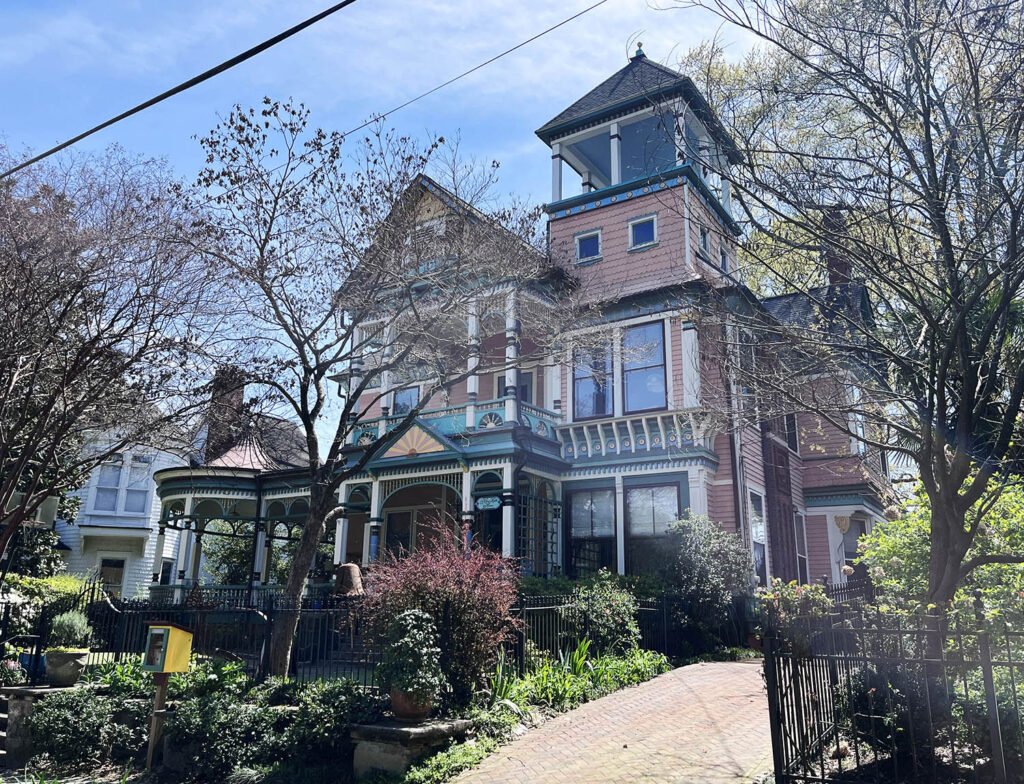
The Glenn House 1890
886 Edgewood Ave
Queen Anne
Reverend Wilbur Fisk Glenn built this Queen Anne for his family. He was a Methodist minister, whose daughter, Flora, married into the Candler family. The Glenn Memorial Church on the campus of Emory University is named after the reverend. The current owners embarked on a massive project to restore the Glenn House to its former glory. They shared each step on social media.

Inman Park Lock Box
47 Delta Place – in the park
This lockbox served the Atlanta Police Department from 1890 until 1905. In the days before automobiles this lock box allowed neighborhood officers to lock someone up until the horse drawn police wagon made its rounds to pick up the person being detained. The lock box was large enough that two people could fit inside – however not comfortably! The Cyclorama’s Grant Park location found the lock box in its basement and returned it to its original home in Inman Park in 1975. Step inside and see how cozy it is for yourself!
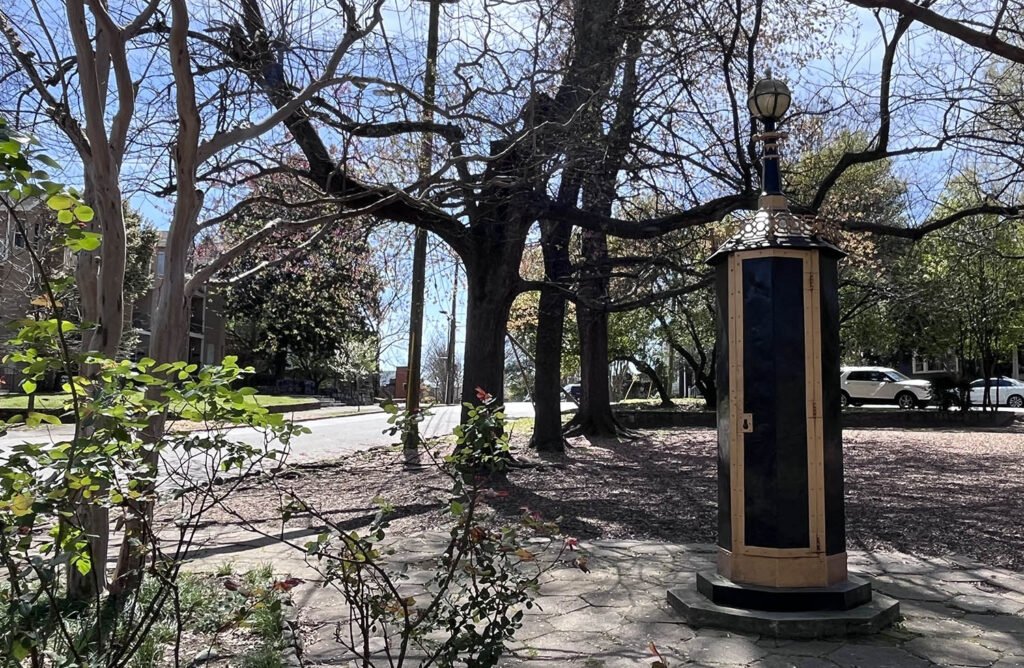
Winship House 1890s
814 Edgewood Ave
Queen Anne
This house was built for Robert and Mary Frances Winship. The house was initially painted maroon with black trim and was considered quite striking. The Winship family rebuilt their company following the civil War into one of the country’s major foundries. It was located in downtown Atlanta. Their daughter Emily Carolyn Winship married Ernest Woodruff. Ernest’s sister Annie and her husband Joel Hurt lived next door to the Winships.
Hurt helped Ernest Woodruff move to Atlanta and he eventually purchased the Coca Cola company. His son Robert Winship Woodruff grew up to run the Coca-Cola company. Robert Woodruff generously shared his wealth with his hometown. When he lost his beloved mother, Emily to cancer, he donated a large sum of money to Emory to begin what is now known as the Winship Cancer Institute.
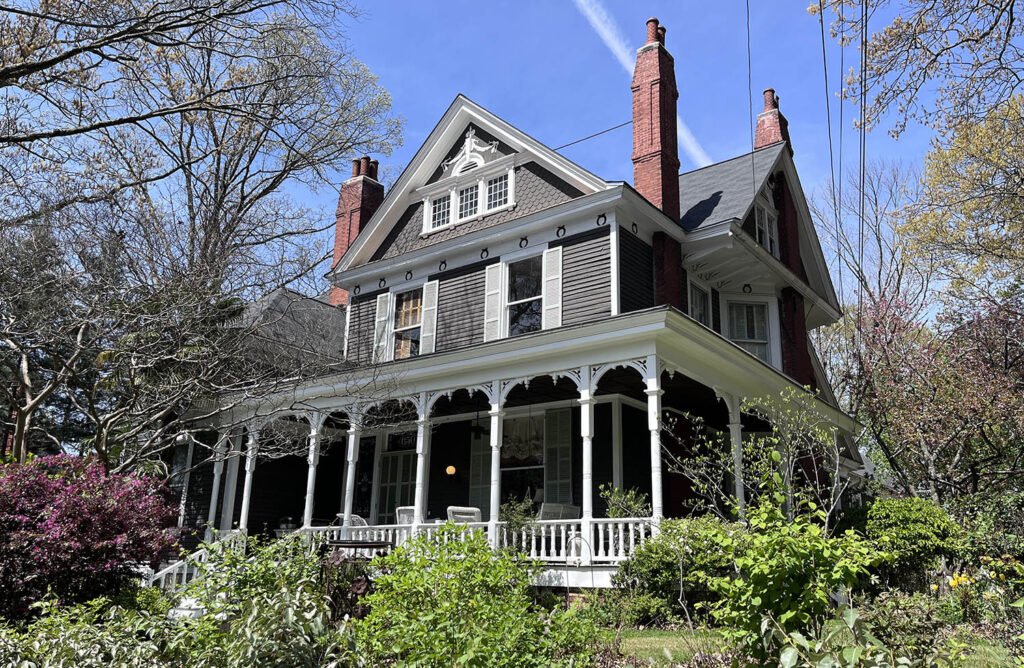
Colonel T.W. Latham House 1892
804 Edgewood Ave
Queen Anne
Sugar Magnolia Bed & Breakfast
This house was one of the initial homes built in the Inman Park neighborhood when it was new. Thomas W. Latham, who practiced as an attorney built this home for his family. During the neighborhood’s decline, the house contained 13 apartments, however it has been restored to its former glory. The house has been the Sugar Magnolia Bed & Breakfast since 1993. Check out their website for a peak inside or better yet, book a room!
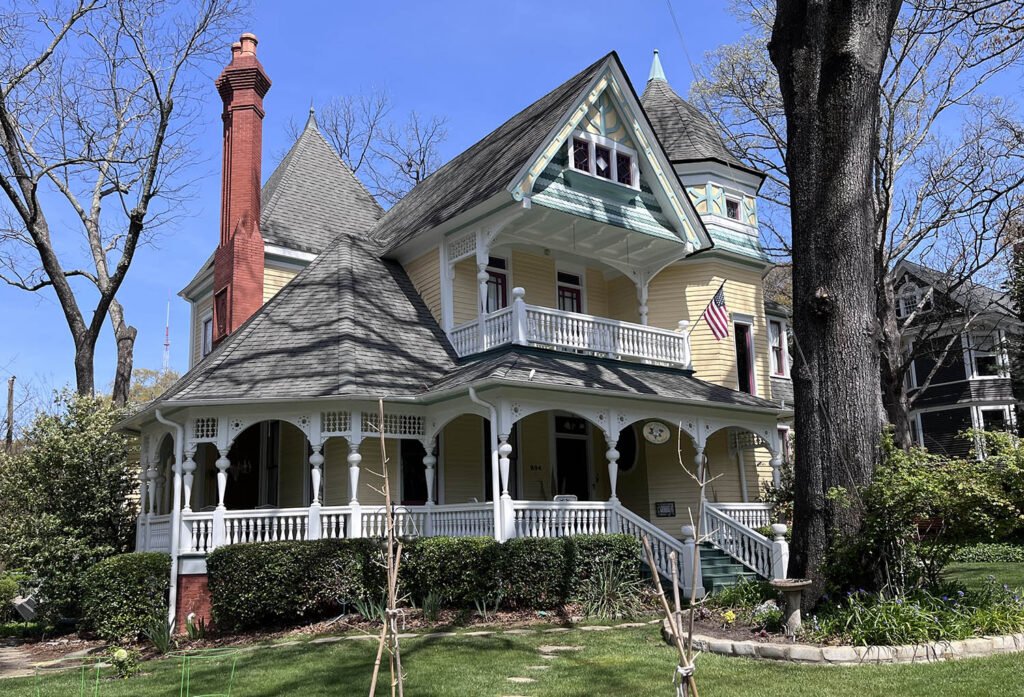
At this point, turn around and head back towards the way you came, except veer to the left onto Euclid Ave
860 Euclid Ave 1892
Queen Anne
This historic Queen Anne home offers a short term rental behind the main house. Look into the carriage house if you are looking for a unique place to stay in Inman Park!

Beath-Dickey-Griggs House 1890s
866 Euclid Ave
Queen Anne
This home was built for John M. Beath who ran Atlanta Ice and Coal. He only lived in the house for a short time before it was sold to John R. Dickey, who worked at the Georgia Stove Works – later Atlanta Stove Works – and today Krog Street Market. The Dickey family enjoyed a long tenure in this house.
In more recent history, the renovation of this house became the turning point for the Inman Park neighborhood making it the neighborhood’s most important restoration. In 1969, when Robert Griggs purchased the house, it was home to 32 boarders, who threw their trash out the windows. The house was split up into five apartments and not a single bathroom or kitchen was in working order.

The First Ernest Woodruff House 1890
882 Euclid Ave
Architect: Gottfried L. Norrman
Queen Anne
This house was built speculatively by Hurt’s East Atlanta Land Company. Ernest Woodruff bought this house for his wife Emily and their young family when they moved from Columbus to Atlanta. Joel Hurt, who was married to Ernest’s sister brought him to Atlanta to run the electric streetcar company that brought residents of Inman Park to downtown Atlanta. They lived here until they built a new home at 908 Edgewood Ave. This was one of the first homes to be scooped up by early urban pioneers and restored.
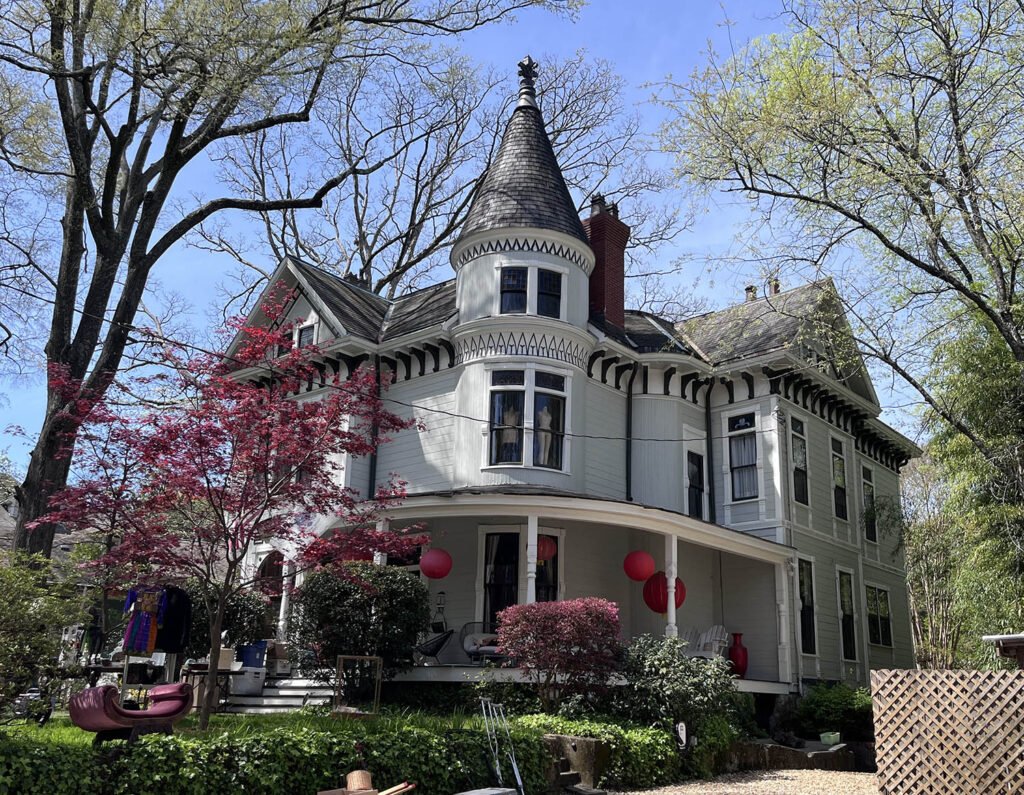
Visit this link to see a few of the houses on Euclid Ave in their heyday.
Continue down Euclid towards Springvale Park. Turn right on Euclid to see the front of the next house on the tour.
Robert W. Woodruff Cottage 1912
100 Waverly Way – on the corner of Euclid Ave and Waverly Way
Architect of addition: J. Neel Reid – note front entrance circa 1913
Victorian and Colonial Tudor Revival
This house was the honeymoon cottage of Robert Woodruff. It was built during the transitional period and includes both Victorian and Colonial Tudor Revival features.

Turn around and head back towards Euclid Ave. Cross Euclid and continue down Waverly Way with Springvale Park on your right.
Aaron Haas House
126 Waverly Way
Shingle Style
Aaron Haas’s aunt and uncle, Jacob and Jeanetta Haas, were the first Jewish family to arrive in Atlanta in 1845. Aaron founded Aaron Haas and Co in 1891. This company became a prominent insurance company and mortgage lender. It later was known as the Haas-Howell Insurance Company and occupied the Haas-Howell Building on 21 Poplar Street, which was designed by architect, J. Neel Reid.

Edwin & Leonard Haas House 1914
140 Waverly Way
Architect: J. Neel Reid
Tudor Revival
Edwin Hass hired the well-known Atlanta architect Neel Reid to design this house next door to his father, Aaron Haas’s, home at 126 Waverly Way. The Hass family was were among Atlanta’s earliest Jewish residents.
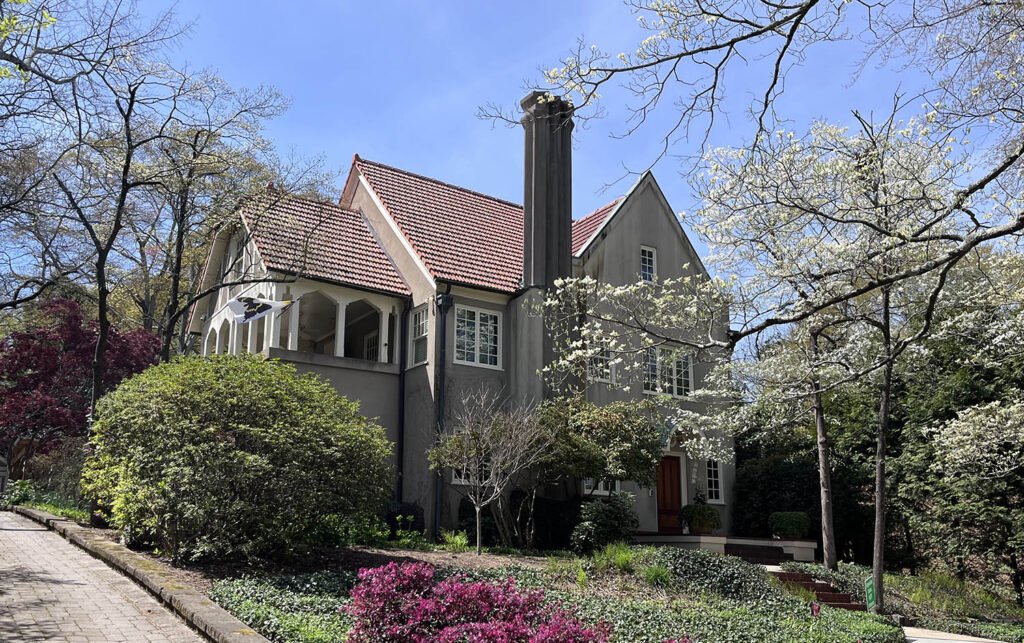
Springvale Park 1889
Landscape Architects: Joseph Forsyth Johnson & the Olmsted Brothers
Joel Hurt hired landscape architect, Joseph Forsyth Johnson to design the park. The park was completed in 1889 and reportedly included Crystal Lake, trees, flowering shrubs, native plants, and flower. In 1903, the Olmsted Brothers landscape company was hired to enhance Springvale Park. Hurt donated Springvale Park to the City of Atlanta, ensuring that we can still enjoy the park today.
This is a picturesque park that includes a pond – with ducks to feed, turtles, picnic tables, and a wonderful playground. The Springvale Park Organization is committed to restoring and maintaining the park.
Originally the park was contiguous, but the DOT used the center of the park to relocate extra dirt from the discontinued I-485 project in the 1980s. The result divided the park in two via Euclid Avenue. The north end of Springvale Park has been restored to the Olmsteds’ design. The southern end of Springvale Park contains a number of historical markers related to the Battle of Atlanta.

Continue up the hill along Waverly Way until you come to Elizabeth Street. Turn right and continue up the street and the next house will be on the left
O’Keefe House 1896
185 Elizabeth Street
Queen Anne Riverboat Style
This was one of the initial homes built in Inman Park. The house was built for the widow of Dr. Daniel O’Keefe, who was a general surgeon. It includes 9 fireplaces.

John Cooper House 1906
166 Elizabeth Street
Shingle Style
The interior of the house includes amazing craftsman woodwork. For a peak inside, check out the October 2020 issue of Atlanta Homes Magazine
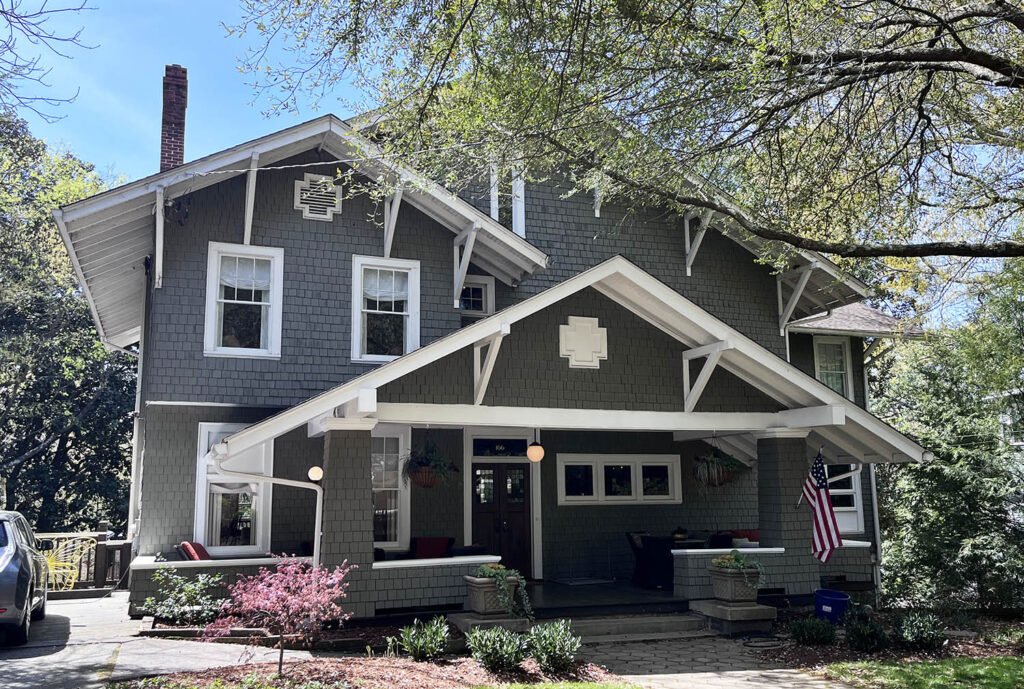
Second Joel Hurt House circa 1906
167 Elizabeth Street
Architect: Walter T. Downing
A combination of Classical, Queen Anne, and Craftsman
Joel Hurt requested that his architect tone down the ornament on this home until they came to this refined design. Hurt held a double wedding for his daughters in this home in November of 1911. Joel Hurt lived in Inman Park for the rest of his life passing away in this house in 1926. Between 1926 and 1980 two retirement homes and a school occupied the building. The house fell further and further into disrepair over the years. In 1984 restoration began on the house. Today it is in excellent condition.
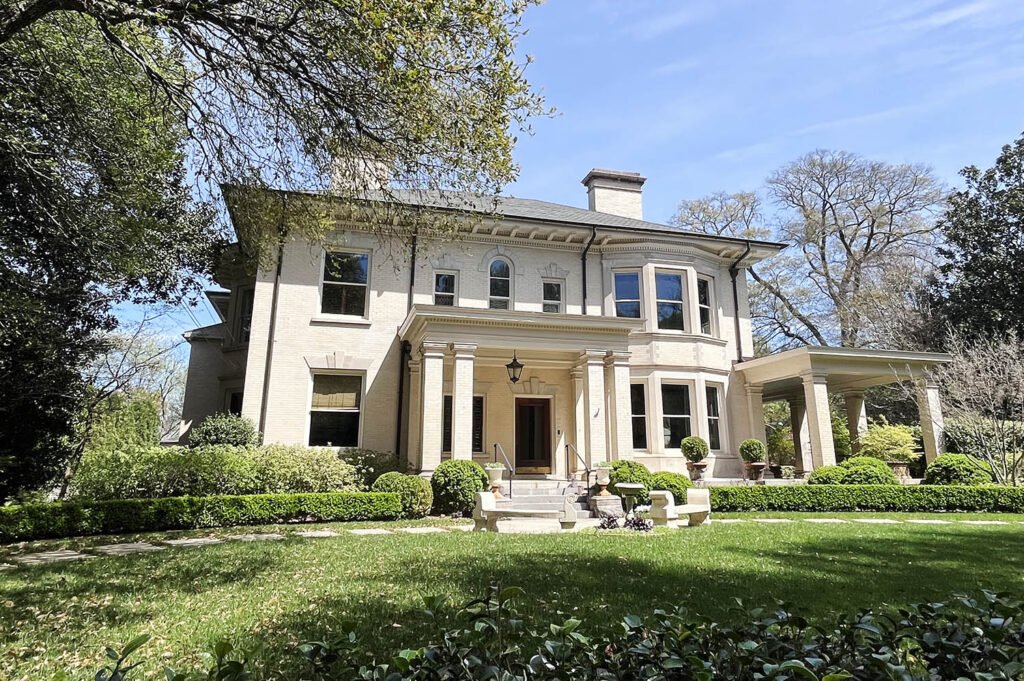
Asa Griggs Candler Mansion 1902-1903
Callan Castle
145 Elizabeth Street
Architect & Builder: George Murphy
Beaux Arts Classical Style
Asa Griggs Candler, who founded Coca-Cola, named his home Callan Castle after the Candler family home in Ireland. He hired the best craftsman available to build the intricate details of this house. He and his wife, Lucy raised 5 children together.
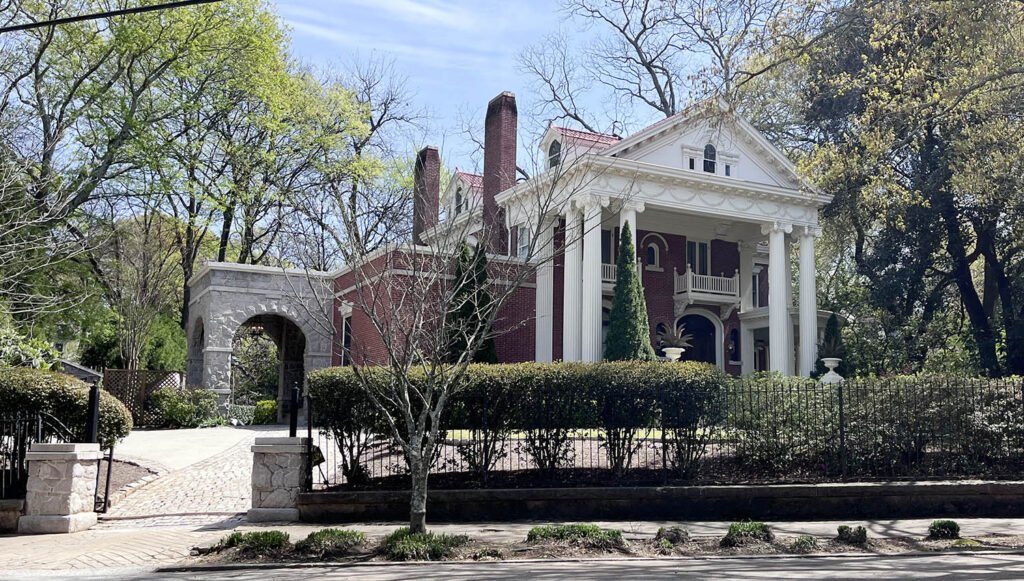
Bishop Warren Candler House
137 Elizabeth Street
Queen Anne
His brother, Asa Candler lived next door. Asa Candler donated $1 million begin Emory University and in return, the institution, which was originally called the Methodist Training Academy was moved from Oxford, Georgia to Atlanta. Warren Candler became the first Chancellor of Emory University.
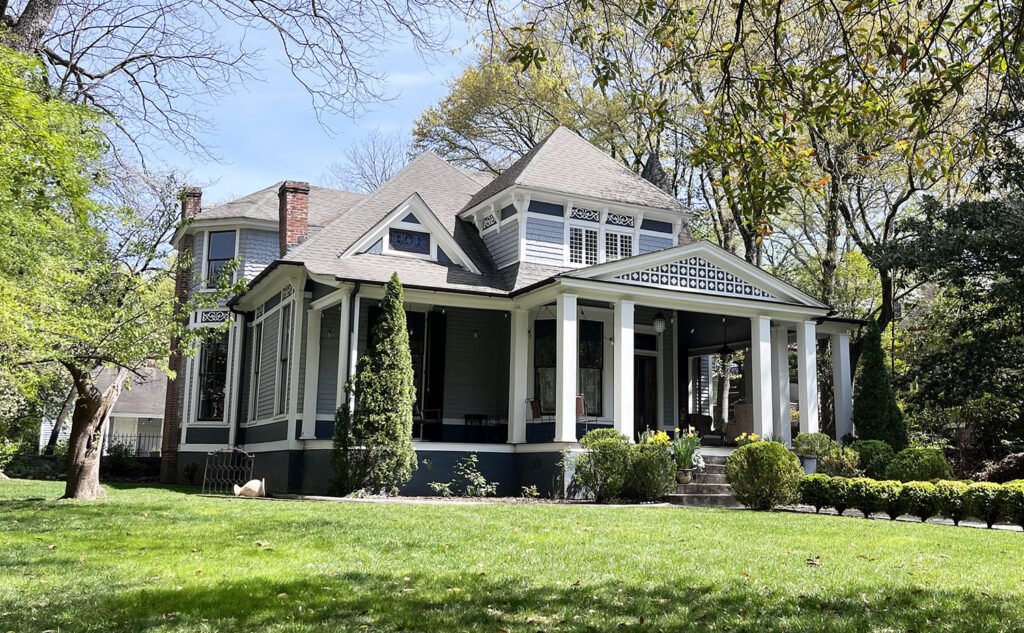
132 Elizabeth Street
Architect: Leila Ross Wilburn
Colonial & Craftsman
This is the only house in Inman Park that was designed by Georgia’s first woman registered architect, Leila Ross Wilburn. She graduated from Agnes Scott College in Decatur before touring the country and photographing houses that inspired her. When she returned to Atlanta in 1906, she gained experience working at an architecture firm before starting her own practice. Her work is prolific because in addition to designing individual houses and apartment buildings, she published a series of pattern books that included modest homes so that good architecture could reach everyone no matter their location or financial status. She also differentiated herself by locating her office in the Peters Building, which was close to the offices of builders and developers who eagerly purchased her plan books. Note this plan in her Southern Homes & Bungalows Plan Book that resembles this house on Elizabeth Street.

127 Elizabeth Street 1900
Folk Victorian Cottage
This house is not original to Inman Park. It was built on Windsor Street and was condemned prior to the construction of Fulton County Stadium. The people who bought it thought it was too cute to be bulldozed, so they had the house moved to a vacant lot in Inman Park. They lived in the garage behind the house, during the renovation.
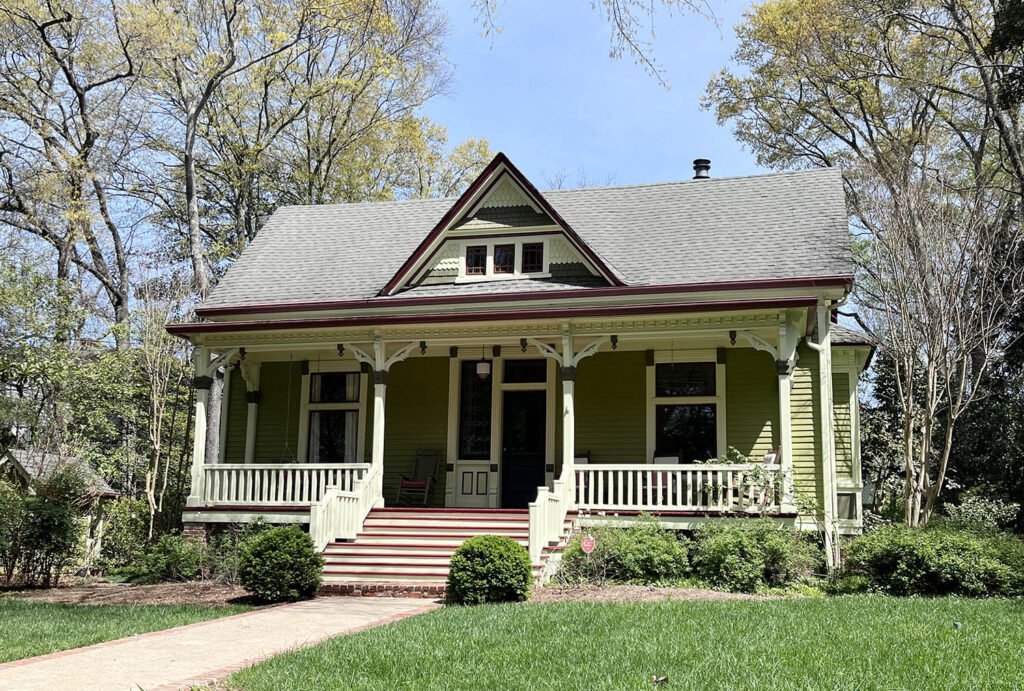
124 Elizabeth Street 1907
Foursquare
This foursquare style house overlooks Springvale Park. In the rear of the house, the building that originally housed the servant quarters still exists.
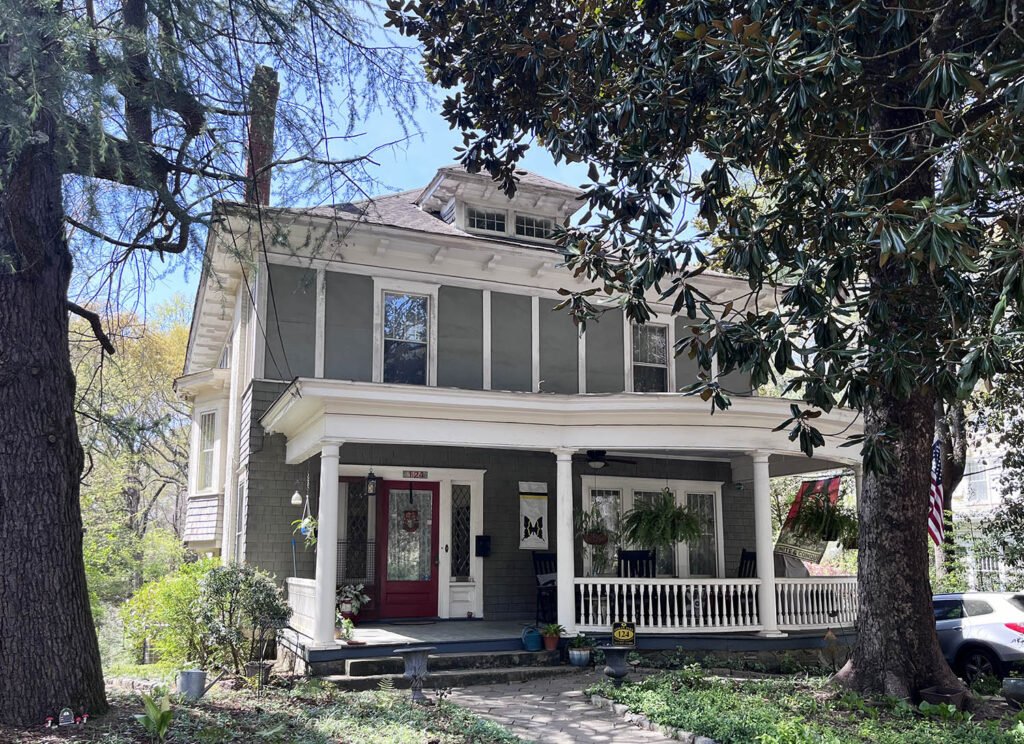
First Joel Hurt House renovated 1886
117 Elizabeth Street
Italianate & Queen Anne
This house is the oldest home in Inman Park. It was the original farmhouse that Joel Hurt’s cousin, Mary Elizabeth Hurt Jones and her husband built following the Civil War. Unfortunately, their farm was the site of the devastating Battle of Atlanta. After Elizabeth Hurt Jones passed away in 1882, her land eventually became part of the assemblage for Inman Park owned by Hurt’s East Atlanta Land Company.
Joel Hurt renovated the Italianate cottage for his family in 1886. He transformed the simple center hall house into a Queen Anne cottage. He physically moved the house and reoriented it front to the newly laid Elizabeth Street, which he named to honor his cousin and the original owner of the cottage. The house was tweaked and renovated multiple times over the years. When the Hurts occupied the house, it had a view of Springvale Park across the street.
Note the California Redwood in the front yard. Hurt planted a redwood, however it was damaged by Georgia’s climate between 1981-1982. The current redwood has replaced its parent tree. For a detailed account of his historic home, please visit this website on the Joel Hurt Cottage.
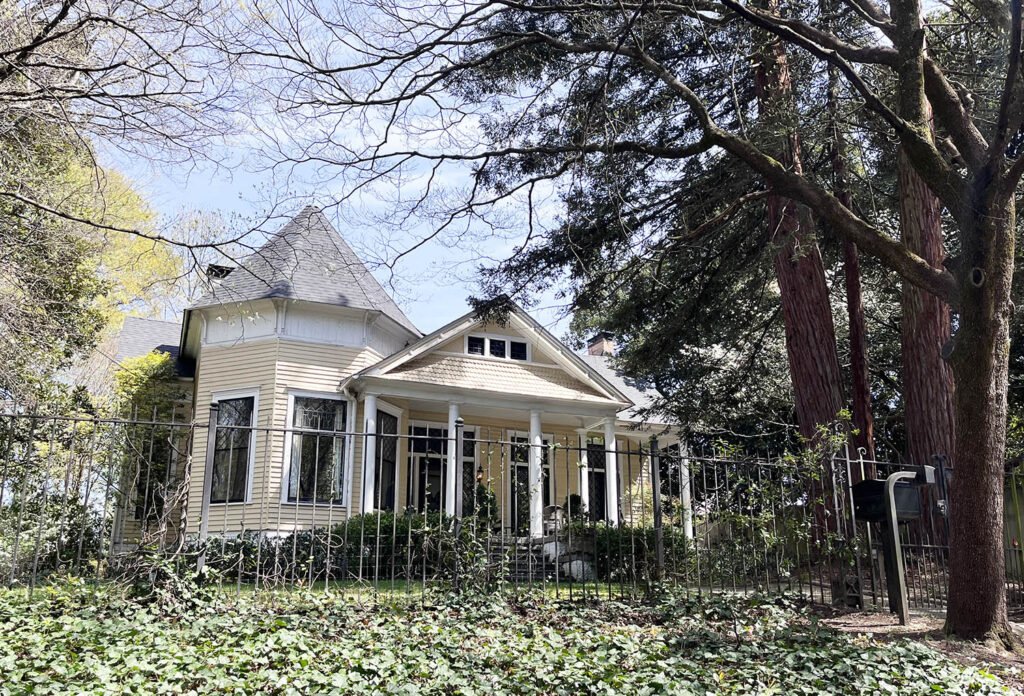
Robert W. Cameron House 1908
116 Elizabeth Street
Neoclassical
This home was built for Robert W. Cameron, who was a wholesale grocer. This house was built from a plan book and it features a symmetrical neoclassical exterior fitted to an asymmetrical Victorian floorplan. Following the turn of the century, the Queen Anne Victorian style had fallen out of fashion. This side of Elizabeth Street was populated with Colonial Revival and Craftsman style houses. During this transition period, builders often built familiar Queen Anne floor plans with classical or craftsman elevation detailing. The house initially included side porches that no longer exists.

Continue to Edgewood Ave, and turn left. The final destination on the tour will be on the right.
Inman Park United Methodist Church 1898
1015 Edgewood Ave
Architect: Willis Franklin Denny II
Romanesque Style using Stone Mountain granite
Dedicated: April 17, 1898
The congregation of this church, which included many of Atlanta’s elite citizens, began gathering in 1866. As these families built their homes in the new and fashionable garden suburb of Inman Park, they decided to built a new church home in the neighborhood. The construction of the sanctuary took 2-years. Asa Candler provided the funds for the new church building. His brother, Warren Candler, was a Methodist Bishop. Along with their brother John, they dedicated the church’s large stained-glass window to their mother, Martha Bernetta Beall Candler. The inscription to her states, “She hath done what she could.” The original pews and podium are still in the church. For more information on the history of the church, visit the congregation’s website.
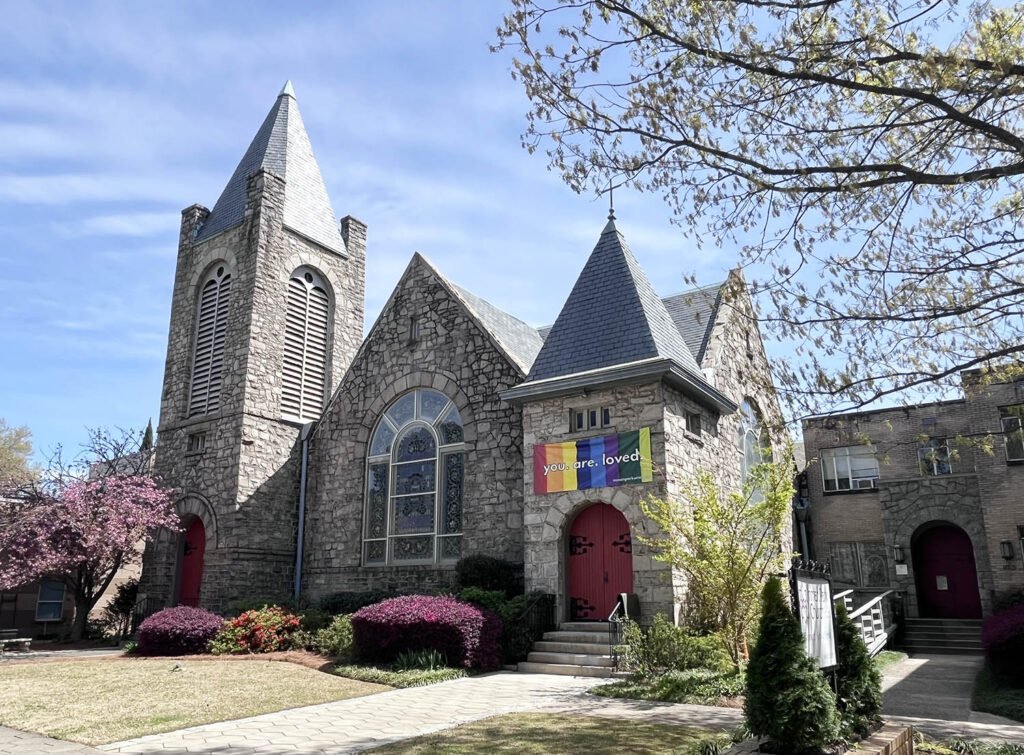
The End of the Free Self-Guided Walking Tour
The Inman Park United Methodist Church concludes our tour. Turn around and head down Edgewood Ave towards downtown Atlanta and the Inman Park Trolley Barn to return to our starting point. Or continue past the Church to grab a bite to eat at the Daily Coffee Shop around the corner or to return to the MARTA Station.
Thank you for allowing me to share the wonderful history of the Atlanta’s Grand Dames in Inman Park with you! If you have any comments or recommendations, please let me know in the comment section below.
Learn More about Atlanta’s Inman Park Neighborhood
Most of the history outlined above is based on the wonderful book, Inman Park (Images of America: Georgia) by Christine V. Marr and Sharon Foster Jones. I highly recommend that you read this book to learn more about the history of Inman Park.
The Atlanta Preservation Center offers excellent walking tours of Atlanta’s historic neighborhoods. If you enjoyed this self guided walking tour of Atlanta’s Inman Park, I highly recommend that you book an in-person tour with the Atlanta Preservation Center. The volunteer guides dive into the history of Atlanta and Inman Park and share their personal stories and perspectives along the way. Look for the tour: Atlanta’s First Planned Suburb: A Walking Tour of Inman Park.
Pin for Later!
